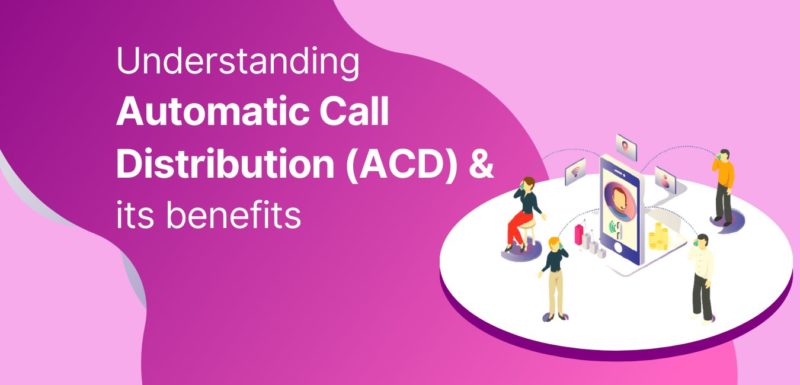In a Call Center, it is frustrating when multiple customer call at the same time and not able to decide Which caller to prioritize or when no agents are available to speak with?
In such scenario, most contact center systems rely on ACD (Automatic Call Distribution) systems which helps call centers to handle and distribute calls efficiently . In most cases ACD is useful in the following scenarios:
- When call volume is excessive
- Offline call center agents
- When you need to manage after-hours calls
- When automating FAQ / repetitive query replies
But isn’t that what IVR does?
An automated call distribution system (ACD) includes several sophisticated capabilities that distinguish it from an interactive voice response system (IVR). In reality, an interactive voice response system (IVR) is frequently a component of an Automatic Call Distribution system.
An automated call distribution system’s primary job is to distribute calls in a programmable manner to different agents based on different parameters like the time of day, the volume of calls received ,the origin of the phone number, the skills necessary to resolve the inquiry, and so on.
What is ACD?
Automatic Call Distribution is a system that routes incoming calls automatically to the best-qualified agent to satisfy the caller’s needs. Calls are distributed utilizing an ACD (Automatic Call Distributor) system that includes skill-based call routing, FIFO (First in First out) and priority. Its purpose is to manage the large volume calls and avoid overwhelming the agent. Thus improves customer experiences by connecting to a capable agent in the quickest time possible.
How does ACD works?
The call distribution process can be summarized in three process
- Caller Identification – Caller ID systems are used to identify things such as the language spoken and the location of the caller. Thus, the ACD will be able to route the caller to the agent who will be most suited to deal with their issue.
- Call Queuing – The next stage is to place all of the callers on a waiting list, which takes some time. How the calls are queued depends on many factors like status, waiting time query etc. In most cases, VIPs are given more priority than regular callers, but the system may also be set to classify callers depending on the other variables listed.
- Call Routing – Finally, call routing. The ACD will route calls according to your preferences. Want to cut down on client waiting time? The ACD may route the incoming call to the most accessible person. Want the best agent handling your customer? This allows you to distribute depending on an agent’s competence. You may pick from many distribution strategies.
Let’s look at the most frequent strategies utilized in contact centers to help you decide which is ideal for your company.
- Rotational call distribution : Call is distributed on rotational way like first caller is attended by first agent , second caller is attended by second agent , and so on This strategy is commonly used when call center want agents to have equal volumes of workload.
- Fixed order call distribution: In this type the calls are distributed to first agents on the list and sent to the next agent if the previous one is busy. This strategy is good if the agents are more experienced and can resolve the issue faster than others.
- Simultaneous call distribution : In this , all the agents received the incoming call at the same time and the first agent that picks the call attend the customer. This strategy is preferred when the call center want to reduce the waiting time.
- Talk-time call distribution: The systems select the agent with the least talk time and assign the next call in the queue. This help to balance the workload between the team and making sure each agent has worked an equal amount of time
- Time-based call distribution: This type of distribution assign the calls based on agents’ availability. The system will alert only to agents that are available and route the call directly or send to voicemail if no agents are available. This is good , If the call center prefers not to take calls after office hours.
- Skills-based routing: In skills-based routing, the ACD prioritizes an agent based on certain skill sets like language proficiency, efficiency, expertise, response time and so on. With this routing strategy, callers will be routed directly to the agent with the most relevant skills.
How it benefits to Contact Center?
Quick Responses : One of the most obvious advantages of ACD is the ability to answer incoming calls immediately. The technology also automatically directs calls to the most relevant agent based on predefined parameters hence save time by reducing call transfer time. More crucially, ACD allows clients to arrange a call back when the contact center is busy, saving them time. VIP customers are promptly sent to the computer-assigned agents without any delay.
Better workforce management : As ACD route the calls in a systematic manner, it helps the call center to make sure the work overload is equally distributed and reduces agents’ idle time.
Improved Customer Satisfaction : Customer got frustrated when call is transferred to multiple agents without any solution to their query. ACD route the calls intelligently to the best suited agent that can handle the customer query effectively. This helps in delivering highly responsive customer service resulting in higher customer satisfaction level.
Increased Agent Productivity : With ACD, call center agents are able to handle calls in which they are trained and expertise. This help in increasing agent’s confidence in dealing with the customer and also improve their productivity.
In addition, ACD may be used in conjunction with other technologies, such as IVR and CTI, to profile callers and offer agents detailed information about the person they are interacting with. As a result, an agent may spend more time in helping customers rather than looking for a caller information thus reduces call handling time, improves the agent’s productivity and efficiency.
Collaboration : Integrating ACD with other tools like CRM, Helpdesk, WhatApp, Chat etc enables the agent to track complete customer interaction in one platform rather than opening multiple tools for customer information. The integration will also enables the entire team to access the updated customer information and can assist the customer faster when call is transfer to different agent or departments. Thus, it helps in streamlining the process more efficient and effectively
Effectiveness : ACD’s advanced speech analytic capability allows businesses to acquire entire transcripts of phone conversations. These transcripts may help assess consumer concerns and how to better fix them.
The technology also helps the organization understand which agents are most equipped to meet certain consumer demands and how effectively to engage them.
Decrease in Call Center costs : Responding quickly to a customer’s issue and sending them to the relevant team increases first-call resolution rates which automatically reduces the time taken to answer the query. Hence, the contact center’s cost per call will reduce.
Conclusion
As previously stated, the advantages highlight the importance of incorporating technological advancements such as Automatic Call Distribution into the contact center’s daily operations. When faced with the enormous amount of competition that exists across all business sectors, implementing a system that promotes exceptional customer service is an excellent option for any company seeking to differentiate itself and maintain a competitive advantage in its industry.
If you are looking to implement Contact Center Solution with ACD feature, Do contact us or leave your comment below.




Leave A Comment